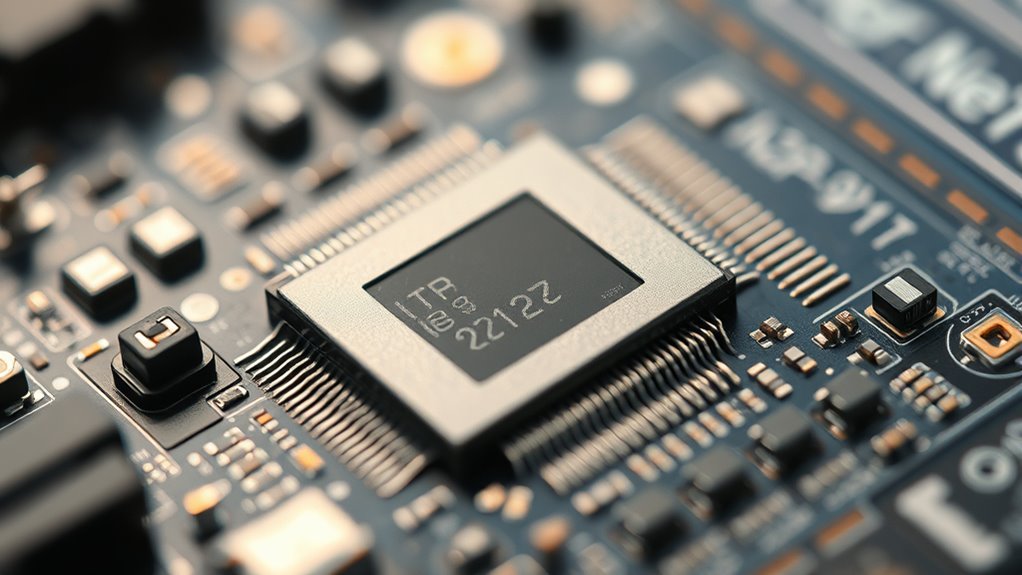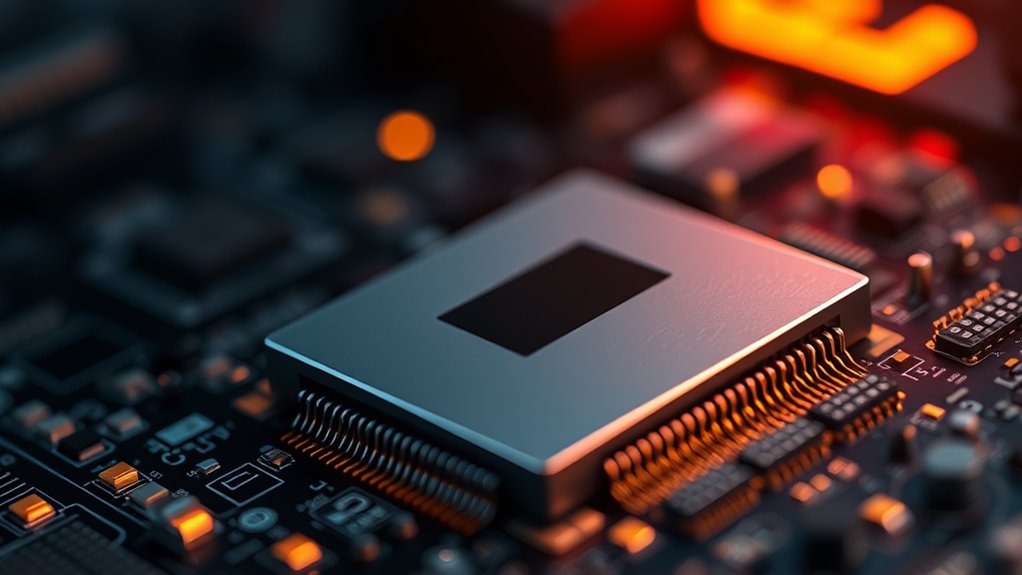Edge-AI chips are tiny silicon devices that bring artificial intelligence right to your gadgets, enabling real-time data analysis on the device itself. This means faster decisions, better privacy, and less reliance on internet connections. They are designed to be highly power-efficient, making them perfect for smartphones, drones, or IoT sensors. Despite manufacturing challenges, ongoing innovations are improving their performance and scalability. Keep exploring to discover how these small chips are transforming your device interactions.
Key Takeaways
- Edge-AI chips enable real-time data analysis directly on devices, reducing latency and dependence on cloud processing.
- They are designed for low power consumption, extending battery life in portable and IoT devices.
- Manufacturing these chips involves advanced fabrication techniques, making production complex and costly.
- Hardware accelerators like NPUs optimize performance and energy efficiency for instant analytics.
- Ongoing technological advances are driving scalable production and improved capabilities of Edge-AI silicon.

Edge-AI chips are revolutionizing how devices process data by bringing artificial intelligence directly to the device level, rather than relying on cloud-based servers. This shift allows for faster decision-making, enhanced privacy, and reduced reliance on internet connectivity. As you explore these tiny silicon giants, you’ll notice that their power efficiency is a standout feature. Unlike traditional processors that consume significant energy, Edge-AI chips are designed to operate with minimal power, making them perfect for battery-powered devices like smartphones, drones, and IoT sensors. This power-conscious design ensures longer operational periods without frequent recharging, which is vital for applications where energy resources are limited.
However, developing these chips isn’t without its hurdles. One of the major challenges you face in manufacturing Edge-AI chips is fabrication. These chips require highly specialized processes to integrate complex neural network capabilities into a tiny silicon footprint. Achieving the right balance between performance and size involves advanced fabrication techniques, often pushing the limits of existing semiconductor manufacturing technology. As a result, producing these chips can be expensive and time-consuming, with a higher risk of defects or inconsistencies during fabrication. These challenges mean that scaling production to meet global demand demands ongoing innovation and investment.
You also need to think about that the design of Edge-AI chips must optimize for both power efficiency and processing power. This involves intricate engineering to guarantee that the chips can handle real-time analytics without overheating or draining batteries quickly. To accomplish this, manufacturers often incorporate specialized hardware accelerators, such as neural processing units (NPUs), that boost AI performance while maintaining low energy consumption. These components allow for rapid data processing at the edge, enabling devices to analyze information instantly and act accordingly. The result is a seamless user experience with faster response times and improved privacy since sensitive data stays on the device rather than being transmitted to remote servers. Additionally, advancements in semiconductor fabrication technology are crucial for overcoming current manufacturing limitations and enabling scalable production of these powerful chips.
Frequently Asked Questions
How Do Edge-Ai Chips Compare to Traditional Cloud-Based AI Processing?
When comparing edge-AI chips to traditional cloud-based AI processing, you find that edge chips efficiently run neural networks locally, reducing latency and bandwidth use. They’re highly power-efficient, making them perfect for real-time analytics on devices. Unlike cloud processing, which relies on distant servers, edge-AI chips process data instantly, offering faster responses and better privacy. This shift allows you to deploy smarter, more responsive solutions directly on the device.
What Are the Main Challenges in Developing Edge-Ai Chip Technology?
When developing edge-AI chip technology, you face key challenges like improving power efficiency to extend device battery life and managing manufacturing complexity due to tiny, intricate designs. You must balance high performance with low energy consumption, making manufacturing processes more complicated. Overcoming these hurdles requires innovative engineering, advanced materials, and precise fabrication techniques to guarantee these chips are reliable, scalable, and capable of handling real-time data processing at the edge.
How Secure Are Data Processed by Edge-Ai Chips Locally?
When it comes to local data privacy, the security of data processed by edge-AI chips depends on robust chip security measures. These chips are designed with encryption, secure boot processes, and hardware-based protections to prevent unauthorized access. While they offer improved privacy since data stays local, you should still guarantee the device has up-to-date security features and regular updates to mitigate evolving threats.
Can Edge-Ai Chips Be Upgraded or Reprogrammed After Deployment?
You can often upgrade or reprogram edge-AI chips after deployment, but it depends on the chip’s design. Many chips allow firmware updates, enabling you to improve performance or add features. Hardware updates are less common and may require physical modifications. Always check if the chip supports remote firmware updates, which make it easier to keep your device current without replacing hardware, ensuring continued security and functionality.
What Industries Benefit Most From Edge-Ai Chip Implementation?
Oh, the industries lining up for edge-AI chips like it’s a fashion trend! Manufacturing automation and healthcare diagnostics top the list. You’ll find these tiny giants transforming factories into smart hubs and doctors into tech wizards. They enhance efficiency, accuracy, and speed—making your favorite industry smarter, faster, and more efficient. So, if you’re in those sectors, get ready to enjoy the benefits of real-time insights powered by tiny silicon giants!
Conclusion
Imagine deploying an edge-AI chip in a smart security camera that instantly detects intruders, alerting you in real-time without relying on the cloud. These tiny silicon giants make such instant decisions possible, transforming how we monitor and protect our spaces. As technology advances, you’ll find yourself relying more on these powerful, compact chips to deliver fast, efficient insights—making everyday life safer and smarter. Edge-AI chips truly are the future of real-time analytics.










